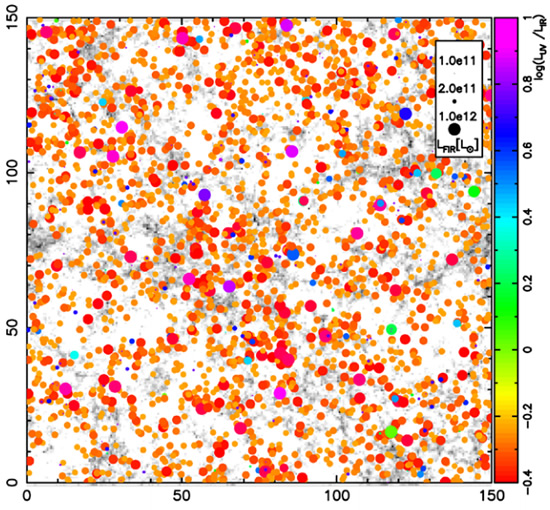Research Gallery > Extragalactic Astronomy
Research Gallery
Extragalactic Astronomy
| A simple approach to the high-redshift sub-millimeter galaxies |
|
Image Credit: Suwa, Hirashita and Tamura

Simulated galaxy distribution. Each point corresponds to an individual
galaxy, whose luminosity of dust emission at a submillimeter
wavelength of 0.85mm is calculated individually. Therefore, the figure
predicts the early Universe (z = 6) that ALMA would see. The larger a
point is, the more luminous the galaxy is. The redder a point is, the
larger fraction of energy is radiated in submillimeter. We only plot
galaxies that are detectable by ALMA. The gray-scale shows the
distribution of the dark matter, whose gravity attracts galaxies. From the
figure, we see that ALMA can detect huge number of galaxies. We also
find that "red" galaxies are the dominant population. Here, "red" means
that a galaxy radiates more in the submillimeter than in the optical (so it
is different from normal red). The existence of dust makes galaxies
"redder", because dust absorbs optical light and emits submillimeter
radiation. We emphasize that if the galaxies have "redder" colors, the
importance of ALMA is more pronounced. Therefore, a lot of red points
in the figure indicate that ALMA is really essential in observing the early
Universe.
|
| There are billions of billions of galaxies in the Universe, and they are not uniformly distributed in space. Rather they are "clustered"; that is, they tend to form large structures in the Universe. The optical (and near infrared in the observers' frame) astronomers have found large-scale structures of galaxies up to redshift of 7. This means that the galaxies have already formed in the first several hundreds of million years in the history of the Universe. Because dust in galaxies absorbs the optical stellar light and re-emit it in the far infrared and submillimeter wavelengths and, perhaps more importantly, dust traces the metal enrichment in galaxies and becomes ingredients for planets, our understanding of early galaxy formation would not be complete without observing in the far infrared and submillimeter.
Therefore, ALMA (Atacama Large Millimeter/submillimeter Array), which has just started observation in submillimeter and millimeter wavelengths, is expected to detect distant galaxies and large-scale structures to redshift of 6 and beyond, and to reveal the blocked (i.e., "hidden") part of the stellar light and to trace the metal enrichment in galaxies. The figure shows the simulation of large-scale structures expected to be seen by ALMA. (Astrophysics and Space Science, 2010, 330, 219) |
 asiaa.sinica.edu.tw Media Request: epo
asiaa.sinica.edu.tw Media Request: epo asiaa.sinica.edu.tw
asiaa.sinica.edu.tw 